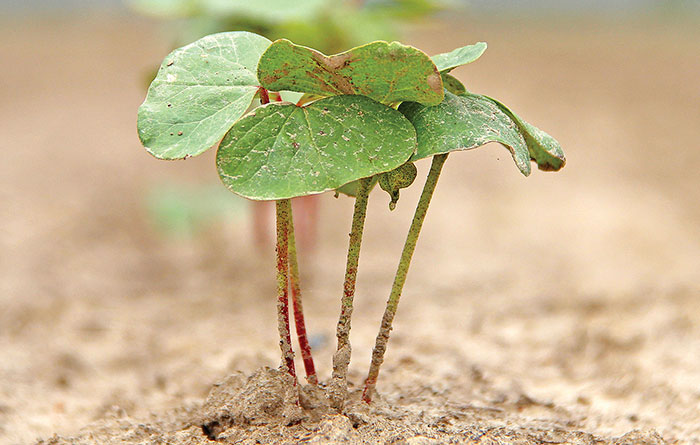
Unlike pigweeds or plant bugs, nematodes are an out-of-sight, out-of-mind pest. Left untreated, however, this parasitic organism in the roots of a cotton plant can substantially reduce cotton yield. Resistant cotton varieties are becoming more critical in combatting this pest.
In west Texas, variety choice is more important than chemical control of nematodes because variety response is more consistent year after year than chemical response, according to Terry Wheeler, Texas A&M University plant pathologist. “Root-knot nematode occurs in about 40 percent of our cotton acreage, and reniform occurs in less than 1 percent. Our resistant cotton varieties are resistant to root-knot.
“Several partial-resistant cotton varieties have been available for several years, including ST 4946GLB2, PHY 367 WRF, and FM 2011GT,” Wheeler says. “Additionally, several newer varieties offer the full resistance package, including PHY 417 WRF and the PHY 427 WRF. I have yet to test Deltapine’s full season varieties, DP 1454NRB2RF and the DP 1558NRB2RF, in a full season environment.”
Wheeler describes partial resistant varieties as having a 50 to 70 percent reduction in nematodes relative to susceptible varieties. The full package of resistance decimates the nematode population dramatically by the end of the season. “If you have a serious root-knot nematode problem, you probably should consider planting the fuller resistant varieties,” she says.
“However, you can’t just consider varietal nematode reduction. Some of the partial resistant varieties can give growers a better yield potential and fiber package than some of the newer resistant varieties in some cases. You need to consider nematode reduction, yield potential and fiber quality when considering variety selection.”
If growers are not having success growing some of these nematode-resistant varieties, they can try a unique cultural method. With water being so light the last few years, several west Texas growers are windshield wiping their pivot circles, concentrating their limited water on cotton planted to half the circle.
“Some rotate the other half of the circle to winter wheat and harvest it, fallow the land the next summer and come back with cotton the following year,” Wheeler says. “It’s a terrific way to reduce nematode populations, and it allows you to plant essentially any cotton variety you want coming out of that wheat rotation.”
Mid-South
From 15 to 20 percent of Mississippi’s sandier cotton land has root-knot nematode issues, and one-third of its heavier cotton ground is infested with reniform nematodes. In the right situation, nematodes can be very damaging — causing up to 25 percent yield loss, says the state’s cotton specialist, Darrin Dodds. “But even lower levels of nematodes might be doing more damage than you give them credit for,” he adds.
Dodds says Mid-South cotton growers’ viable options, particularly in a mid-60 cent cotton market, are a resistant variety, a nematicide seed treatment, and cultural practices. “If you know your field is infested with root-knot nematodes, you can select nematode-resistant varieties from Dow AgroSciences, Bayer and Monsanto,” he says. “Review variety trial data to see how these nematode-resistant varieties have performed. Select the ones that fit your operation and work them into your production system with the nematicide seed treatment and cultural practices to minimize the impact nematodes are having on your farm.”
Growers can do several things from a cultural standpoint to minimize the impact that nematodes have. “No. 1, nematodes interfere with water and nutrient uptake in the cotton plant, so if you get adequate rainfall or irrigate, you can minimize the impact of nematodes. Secondly, you can use a nematicide seed treatment for root-knot and reniform nematodes.
“You pay an extra $30 per bag for a nematicide seed treatment so for $6 per acre, to cover my bases, I’d include the nematicide on the seed because even in a mid-60s cotton market, if you’re paying $6 per acre and the seed treatment gets you another 10 or 15 pounds, it’s paid for itself. It’s part of a package approach to nematode control.”
Southeast
North Carolina consultant Billy McLawhorn is excited about the possibility of true resistance from some of the newer cotton varieties. “If it’s anything like we’ve had on soybeans, it’ll be phenomenal,” he says. “We’ve seen root-knot numbers in the thousands drop to negligible counts after a nematode-resistant soybean crop, and I hope we’ll see that with the newer cotton varieties. We watched several resistant cotton varieties in 2015, and are waiting on the results. They can have a big impact on yield in our sandier soils.”
McLawhorn, who takes many nematode assays in the fall, says his growers mainly deal with root-knot nematodes. Reniform nematodes appear in the North Carolina counties that border South Carolina, which has huge reniform problems, as does Georgia.
“We’ve had some partial-resistant cotton varieties in the past, but the newer ones promise to be full nematode resistant,” McLawhorn says. “It’s a tool to clean up cotton fields.”
If a Southeast cotton grower does not plant a nematode-resistant variety and does not use a nematicide in a heavily-infested field, under the right conditions he could easily lose a third of his crop. “But I think you frequently can lose 10 percent to nematodes and not be aware of it,” McLawhorn adds. “And with the current cotton prices, we need every pound of lint we can get.”
About the Author(s)
You May Also Like




